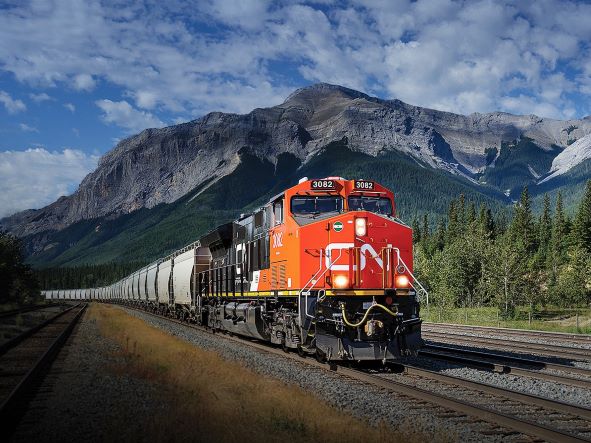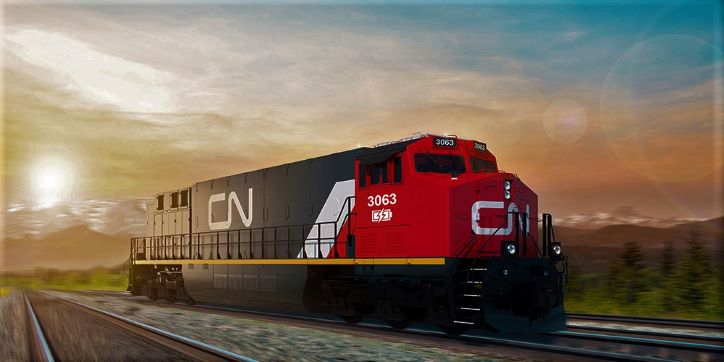Target:
- Canadian National Railway commits to reduce Scope 1 and 2 GHG emissions 43% per gross ton miles by 2030 from a 2019 base year.
- Canadian National commits to reduce Scope 3 GHG emissions from fuel and energy-related activities 40% per gross ton miles by 2030 from a 2019 base year.
Why Canadian National Railway set a science-based target
As a global leader in transportation and trade, Canadian National Railway (CN) transports more than 300 million tons of natural resources, manufactured products and finished goods throughout North America every year. As the only railroad connecting Canada’s Eastern and Western coasts with the US South through a 18,600-mile rail network, CN’s goal is to conduct its operations with minimal environmental impact while providing cleaner, more sustainable transportation services to its customers.
Increased engagement with customers and investors on CN’s emissions reduction strategy led to the development of CN’s science-based target (SBT), which details CN’s level of commitment to reducing its emissions backed by verified climate science. For CN, its SBT is also an important market signal to its supplier ecosystem about the required collaboration relating to renewable fuels and alternative locomotive propulsion. “Setting science-based targets showed robustness, confidence, credibility and offered a way to deliver the level of corporate responsibility our investors, customers, suppliers and other stakeholders expect of us,” said Janet Drysdale, CN’s Vice-President, Financial Planning and Sustainability.
CN was the first Class I railroad and among the first 100 companies globally to set an approved science-based carbon emissions intensity reduction target in 2017. In subsequent years, CN has revised its target to account for operational changes and the latest climate science. In 2021, the company became the first North American railroad to formally commit to setting a net-zero target by joining the Business Ambition for 1.5°C and the United Nations’ Race To Zero campaign.

How they plan to achieve their target
CN is simultaneously pursuing both near-term and long-term mitigation strategies. As approximately 85% of its direct GHG emissions are generated from rail operations, CN’s strategy to meet its 2030 target focuses on five key strategic areas: fleet renewal, innovative technology, big data, operating practices and cleaner fuels. Regarding the last item, the company is actively working with its suppliers on testing the greater use of renewable fuel blends in its fleets, while alternative propulsion locomotive technologies are being developed.
CN recognizes the need for new locomotive propulsion technology to meet the deep decarbonization required to achieve net-zero emissions by 2050. It recently announced the purchase of Wabtec’s FLXdrive battery-electric freight locomotive, the first 100% battery heavy-haul locomotive in support of its ambitious long-term goals. This will help to reduce CN's locomotive consist fuel consumption and emissions by up to 30%. “That purchase, in conjunction with other pilots to be conducted by CN in collaboration with our suppliers and the rail industry, will help open the door to new alternatives beyond the diesel-powered locomotives used today,” said Drysdale.
CN knows that achieving its target depends in part on the continuing successful development and availability of innovative technologies and the availability of sufficient volumes of cost competitive sustainable renewable fuels in the years to come. “The extent of our ability to fully deploy and implement these technologies, as well as to obtain and use sufficient volumes of those fuels will require collaboration between locomotive manufacturers, fuel producers, governments, supply chain partners, universities and cleantech," said Drysdale. “This ecosystem of collaboration is a key area of focus for us.”
The carbon footprint of CN’s non-rail operations comprises approximately 15% of its total direct GHG emissions. Different sectoral decarbonization approaches (SDAs) are used to define its near-term targets for trucking and vessel fleets and they are all integrated with its rail fleet target into one overall target. To reduce non-rail emissions, CN continues to implement best practice initiatives, including fleet upgrades, new equipment and technologies as well as yard and building retrofits.
CN has perspective to offer companies that have yet to join the Science Based Targets initiative (SBTi). “With growing focus on climate change and company actions to mitigate the related risks, it is important to use comparable approaches that promote transparency for end users,” said Drysdale. “Hence the SBTi is a key player in helping provide clarity into strategy and progress as the world transitions to net-zero.”

